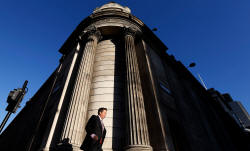|
 BoE's
Cunliffe tells banks to prepare for post-"too big to fail" world BoE's
Cunliffe tells banks to prepare for post-"too big to fail" world
 Send a link to a friend
Send a link to a friend
[May 13, 2014]
By Huw Jones
LONDON (Reuters)
— Britain's banks
need to start preparing for a financial environment in which they
are no longer "too big to fail", Bank of England Deputy Governor Jon
Cunliffe said on Tuesday.
|
|
 Taxpayers in Britain poured 65 billion pounds into banks during the
2007-09 financial crisis and the BoE wants to ensure that no bank is
so big that letting it fail would risk the market mayhem seen when
Lehman Brothers went bust in September 2008. Taxpayers in Britain poured 65 billion pounds into banks during the
2007-09 financial crisis and the BoE wants to ensure that no bank is
so big that letting it fail would risk the market mayhem seen when
Lehman Brothers went bust in September 2008.
Speaking at an event held by Barclays <BARC.L> bank, Cunliffe
cautioned lenders that once new rules are in place to ensure that no
bank is too big to fail, market liquidity won't return to levels
seen in the run-up to the financial crisis.
"Liquidity premia were likely too low and liquidity risk very
probably under-priced before the crisis," Cunliffe said.
"Market participants will need to recognize this change in market
structure and adjust their balance sheets accordingly," Cunliffe
added.
One of the rules being finalized is a requirement to hold a buffer
of bonds that can be used to shore up a failing bank once it has
burned through all its regulatory capital.

But Cunliffe said the aim won't be to resurrect every failed
business such as by arranging "hasty shotgun weddings" or forced
takeovers.
The amount of "bail-in" bonds that banks will be required to hold
will only be enough to keep critical operations such as payment
systems going to avoid harming financial stability, while the group
can be safely wound down over time.
"We are not seeking an amount of 'Gone Concern Loss-Absorbing
Capacity' capable of resurrecting any failing banks including the
global giants," Cunliffe said.
Cunliffe's boss, Bank of England Governor Mark Carney, who is also
chairman of the G20 economies' Financial Stability Board, said in
March that the board wants to crack "too big to fail" bank barriers
by Christmas.
LEVERAGE RATIO
Another global rule being finalized is the leverage ratio, which
acts as a cap on a bank's balance sheet.
A preliminary ratio of 3 percent was set and global regulators will
decide in 2017 what the final minimum level should be, though
countries like the United States are already moving to a much higher
requirement.
[to top of second column] |

Some bankers expect Britain's lenders will be required to have a
leverage ratio of 4 percent or above regardless of what's decided at
the global level.
The government has asked the BoE's Financial Policy Committee to
review if the global leverage rule should be introduced earlier in
Britain.
Cunliffe said the Bank will hold a public consultation on this and
on a possible new power to vary a bank's leverage ratio.
Regulators are putting pressure on the swaps industry to revise
trillions of dollars of contracts by inserting a clause that allows
for such contracts being temporarily prevented from being closed out
while a bank is being wound down.
The industry says that big investors or "buy side" players have
legal difficulties with this. But Cunliffe signaled that regulators
won't be deterred.
"The way forward will likely entail the major dealers, the 'sell
side', who together account for around 80 percent of contracts in
the market, moving first," Cunliffe said.
Ensuring that no lender is 'too big to fail' is not only seen as
crucial to shielding taxpayers but also to restoring trust among
regulators after the collapse of Lehman Brothers soured relations,
leading to unilateral national measures on capital rather than
global coordination.
(Reporting by Huw Jones; Editing by Jemima Kelly and Hugh Lawson)
[© 2014 Thomson Reuters. All rights
reserved.] Copyright 2014 Reuters. All rights reserved. This material may not be published,
broadcast, rewritten or redistributed.
 |